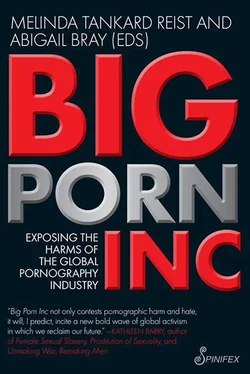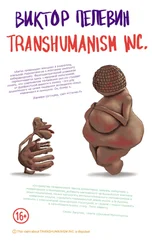The obvious question here is: what effect could these sites have on the viewers? Once they click on these sites, users are bombarded – through images and words – with an internally consistent ideology that legitimizes, condones, and celebrates a sexual desire for children. The norms and values that circulate in society and define adult–child sex as deviant and abusive are wholly absent in PCP, and in their place is a cornucopia of sites that deliver the message (to the viewer’s brain, via the penis), that sex with children is hot fun for all.
There is a wealth of research within media studies that shows that people construct their notions of reality from the media they consume, and the more consistent and coherent the message, the more people believe it to be true. [27] 5 For a discussion of the findings of over 30 years of studies on how media shapes the social construction of reality, see Gerbner (1998).
Thus, the images of girls in PCP do not exist within a social vacuum, but rather are produced and consumed within a society where the dominant pop culture images are of childified women and hypersexualized, youthful female bodies. Encoded within all of these images is an ideology that encourages the sexual objectification of the female body, an ideology that is internalized by both males and females, and has become so widespread that it normalizes the sexual use and abuse of females. This does not mean that all men who masturbate to PCP will rape a child, or even be sexually attracted to a child. What it does mean, however, is that on a cultural level, when we sexualize the female child, we chip away at the norms that define children as off limits to male sexual use. The more we undermine such cultural norms, the more we drag girls into the category of ‘woman’, and in a porn-saturated world, to be woman is to be a sexual object deserving of male contempt, use, and abuse.
Gerbner, George (1998) ‘Cultivation Analysis: An Overview’ Mass Communication and Society 1 (3&4), pp. 175–194.
Jensen, Robert (2007) Getting Off: Pornography and the End of Masculinity . South End Press, Boston.
Jhally, Sut (1990) ‘Image-Based Culture: Advertising and Popular Culture’ The World and I , July, pp. 506–519.
Quayle, Ethel and Max Taylor (2002) ‘Child Pornography and the Internet: Perpetuating a Cycle of Abuse’ Deviant Behavior 23 (4), pp. 331–361.
Russell, Diana and Natalie J. Purcell (2006) ‘Exposure to Pornography as a Cause of Child Sexual Victimization’ in Nancy E. Dowd, Dorothy G. Singer, and Robin Fretwell Wilson (Eds) Handbook of Children, Culture and Violence , pp. 59–82. Sage Publications, Thousand Oaks, CA.
Catharine A. MacKinnon
(USA)
X-Underrated: Living in a World the Pornographers Have Made [28] 1 This is an edited version of ‘X underrated’ published in the UK Times Higher Education , http://www.timeshighereducation.co.uk/story.asp?sectioncode=26&storycode=196151 .
The belief that pornography inhabits its own physical and mental world is an illusion. Nothing restricts its effects. Yet the protective myth of its spatial separation and cognitive confinement endures, even as pornography visibly takes over more and more public and private space, invading homes and offices and transforming popular culture.
There is such a thing as pornography, as its producers and consumers well know. No one is making tens of billions of dollars from, or masturbating to, the Bible, for example. This is only to notice that the pornography industry and mass media have long operated in separate spheres defined by content. In the name of taste, values or division of labour, legitimate cinema, books and media have traditionally eschewed or coyly skirted the sexually explicit. The ‘adult’ movie industry, cable television and ‘men’s entertainment’ magazines have frontally specialised in it. This mutually clear line, quite precisely and effortlessly observed in practice, coexists with the common cant that pornography cannot be defined or distinguished from anything else.
Pornography is increasingly making popular culture more pornographic. This effect is routinely observed and sometimes deplored, whether for sexually objectifying women yet more inescapably, or for taking away the sexiness of the forbidden. But if this movement is rarely documented, and even more seldom explained, the fact that pornography itself has been a popular feature of culture – the most mass of media – for some time is never faced.
Society’s ideology of compartmentalisation – that the rest of life can go on unaffected – never seems to be embarrassed by pornography’s ubiquity. It has been in plain sight all along. In reality, pornography’s place is just down the street, right there on the rack in the convenience store, not to mention in the bedrooms and bathrooms of homes where its users seldom live alone. Yet even as the industry has burgeoned, taking over more public space and penetrating more deeply into private life at home and at work with each advance in technology, it is considered to be somehow not really there.
The same dissociative logic structures the legal regulation of pornography.
Obscenity, one meaning of which is off stage, is located in some neighbourhoods and not others. The question of where is politically fought over locally like the placement of noxious waste, as if its effects can be so confined. Pornography has to be somewhere, the attitude is, the only question is where. (One reading of the law of this subject in the USA revolves around how far a man has to travel to get his fix before it becomes unconstitutional.) Pornography is considered addressed by the legal sleight of hand through which it is imagined placed in some demimonde: over there rather than right here.
Beyond the geographical, the psychological disconnect is perhaps most socially potent: the delusion that pornography is ‘fantasy’. ‘No woman was ever ruined by a book’, as the slogan goes. This gives using pornography a certain deniability. Never mind that someone has to be sexually used to make the visual materials that form the vast majority of the industry’s output. Never mind that among the first and most robust of the results of consumption is the spontaneous generation of rape fantasies, or that people often do what they imagine they want to do. Never mind that ‘fantasy’ is the word used by a man convicted of being about to make a snuff film of a boy, to describe the detailed plans he was intercepted discussing, or what the media reported a man was having with a prostitute whom he drowned in a bathtub.
One telling episode in these annals of denial arose in the publication of American Psycho , an upmarket, high-concept work of fiction in which one woman after another is sexually slaughtered. Women are skinned alive, mutilated, raped and one dismembered head is used for oral sex, all in graphic and explicit terms. Simon and Schuster, in an exceptional move, rescinded its contract of publication shortly before the book was due out.
It was rumoured by insiders that women on the staff refused to have it published in their house.
The publishing industry has long coexisted with – at times affirmatively defended – the pornography industry. This includes the film Snuff , a sex movie available since 1972 right down the street from Simon and Schuster, in which a woman is shown being disemboweled while alive. The shock of, hence the opposition to, American Psycho was apparently that it was here, in mainstream publishing. As long as sexual killing is happening ‘over there’, it is as if it is not happening at all. American Psycho seemed to shatter that illusion of context for some people, at least momentarily. The book was quickly bought and published by Vintage, a division of Random House.
Читать дальше












